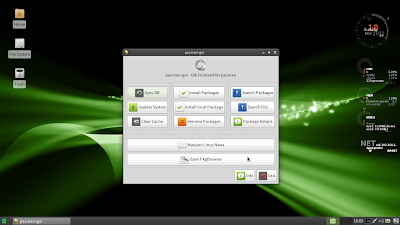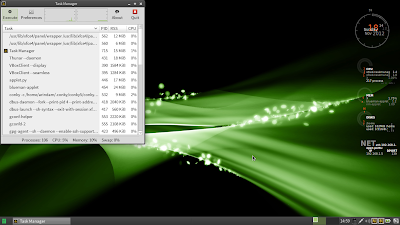The flagship distro from the Manjaro stable is perhaps the XFCE version. I was deeply impressed by the refinement and functionalities offered by KDE version. The XFCE version, too, lived up to the standards set in 0.8.1 release. I tested it out on my Asus K54C, 2.4 Ghz Core i3 processor with 2 GB RAM. First I did a live boot followed by installation on an 8 GB partition specially created for Linux distro testing.
XFCE 4.10 is the desktop environment with Linux kernel 3.4.18 in this edition. The desktop looks really bright and has a really good looking conky! New wallpaper is also better than the previous default wallpaper. The 32-bit ISO is 1.2 GB and lower in size than the 0.8.1 release (1.5 GB). I thought the developers would have packed all the goodness of 0.8.1 release in a smaller package - however, when I booted it up I saw a trimmed version of the former release. A lot of applications like, Openshot video editor, complete LibreOffice suite, PlayonLinux, etc. are not in the updated edition. A letdown after the 0.8.1 release for sure. A list of major applications available in 0.8.2 is given below:
- Graphics: GIMP 2.8, Viewnior, Simple Scan
- Internet: Firefox 16.0.2, Pidgin chat client, Skype 4, Thunderbird 16, XChat, Remote Dekstop
- Multimedia: SMPlayer, DeaDBeef, Xfburn among others
- Office: LibreOffice Calc, LibreOffice Writer, epdf viewer, Orage calendar, etc.
You can read my review of the 0.8.1 XFCE release
here. The updated 0.8.2, too, works out of the box like the former release and is pretty easy to install on the hard disc.
On package management and installation of applications, I liked the 0.8.1 release more than the present release. Earlier release had a simple pacman gui where applications are grouped into different classes on the left hand panel. You can either search or directly go to the category and browse for the package you would like to install. However, present release complicates things by giving a package browser (where you can browse packages, check dependencies, etc. but unfortunately can't install!) and a pacman-gui (where you write the package name noted from the package browser and it will open a terminal to install). This is a bit funny and unnecessarily complicated when things can be a lot simpler.
I would like the previous pacman package interface back and the new interface doesn't appeal to me at all! However, installing packages like Openshot video editor, PlayonLinux, Docky, etc. wasn't a big deal even on the new release. Only thing, I had to do back and forth a few times to install them. With a couple of panels I created a Gnome 2 look from XFCE.
Rest is pretty much the same. On my system after installation, the default desktop would consume about 1-5% CPU and 160-200 MB RAM, like the previous edition. The distro is smooth to use and offer good multi-tasking ability even within limited resources.
Overall
In overall, I would stick to the earlier release (0.8.1), which I thought as one of the best XFCE releases of the year. Given Archlinux has a rolling release, it is just a matter of updating the old version. As you can see in the screenshot below, it is just a matter of downloading around 500 MB of updates to make it the latest version. I didn't download the new package manager but rather stick to the tried and tested old one.
Package manager issue aside, the distro is really good and if you are looking for a rolling release slick XFCE distro, then you should try Manjaro XFCE!






Manjaro seems to be a very interesting distro, I should give it a try.
ReplyDeleteIf I think of a Archlinux working out of the box, then it is definitely Manjaro. I agree, it is interesting and very efficient.
Deleteawesome distro. lite and fast
ReplyDelete